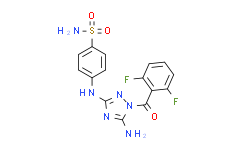| Description: |
JNJ-7706621 is a potent aurora kinase inhibitor, and also inhibits CDK1 and CDK2, with IC50s of 9, 3, 11, and 15 nM for CDK1, CDK2, Aurora-A and Aurora-B, respectively. |
| In Vivo: |
JNJ-7706621 (100 mg/kg, i.p.) exhibits 95% tumor growth inhibition in A375 (human melanoma) tumor xenograft model[1]. JNJ-7706621-loaded micelles inhibit tumor growth, and delay the tumor growth more efficiently than the control JNJ-7706621 suspension[3]. JNJ-7706621 (100 and 125 mg/kg) is efficacious in a human tumor xenograft model under intermittent dosing regimens[4]. |
| In Vitro: |
JNJ-7706621 shows antiproliferative activity against various human tumor cells with IC50s of 284, 254, and 447 nM for HeLa, HCT116, and A375, respectively[1]. JNJ-7706621 inhibits other centrosomal proteins such as TOG, Nek2, and TACC3 in early mitotic phase, but does not prevent localization of Aurora A to the spindle poles. Treatment of nocodazole-synchronized cells with JNJ-7706621 can override mitotic arrest by preventing spindle checkpoint signaling, resulting in failure of chromosome alignment and segregation[2]. JNJ-7706621 suspensions inhibits cell viability of HeLa cells with IC50s of 2.1 and 0.9 μg/mL at 24 and 48 h. The IC50 of the JNJ-7706621-loaded nanoparticles are 35 and 2.7 μg/mL and the IC50 of the JNJ-7706621-loaded micelles are 6.3 and 1.6 μg/mL[3]. JNJ-7706621 shows inhibition of Aurora-A and Aurora-B but has no activity at the highest concentration tested on the Plk1 or Wee1 serine/threonine kinases. JNJ-7706621 also shows potent growth inhibition in vitro on all human cancer cell types with IC50 values ranging from 112 to 514 nM[4]. |
| Kinase Assay: |
To identify compounds that inhibit CDK1 kinase activity, a screening method is developed using the CDK1/cyclin B complex to phosphorylate a biotinylated peptide substrate containing the consensus phosphorylation site for histone H1, which is phosphorylatedin vivo by CDK1. Inhibition of CDK1 activity is measured by observing a reduced amount of 33P-g-ATP incorporation into the immobilized substrate in streptavidin-coated 96-well scintillating microplates. CDK1 enzyme is diluted in 50 mM Tris-HCl (pH 8), 10 mM MgCl2, 0.1 mM Na3VO4, 1 mM DTT, 1% DMSO, 0.25 AM peptide, 0.1 ACi per well 33P-g-ATP (2,000-3,000 Ci/mmol), and 5 AM ATP in the presence or absence of various concentrations of test compound and incubated at 30°C for 1 hour. The reaction is terminated by washing with PBS containing 100 mM EDTA and plates are counted in a scintillation counter. Linear regression analysis of the percent inhibition by test compound is used to determine IC50 values. The Aurora kinase assays are done with 10 AM ATP and a peptide containing a dual repeat of the kemptide phosphorylation motif. |
| Cell Assay: |
HeLa cells are seeded in 96-well plates at the density of 2500 viable cells per well. The cells are then incubated with a suspension of JNJ-7706621, JNJ-7706621-loaded micelles and nanoparticles (JNJ-7706621 concentrations of 0.011, 0.022, 0.11, 0.22, 1.1, 2.2, 11 and 22 μg/mL; dilutions are made in the medium) and drug-free polymeric micelles (polymers concentrations 0.3 mg/mL) and nanoparticles (polymers concentration 5 mg/mL) for 4, 24 and 48 h. The cytotoxicity is assessed using the MTT test. Absorbance is measured at 570 nm using a microplate reader. Untreated cells are taken as control with 100% viability and Triton X-100 1% is used as positive control of cytotoxicity. The results are expressed as mean values ± standard deviations of five measurements. |
| Animal Administration: |
Briefly, animals are implanted s.c. with 1 mm3 A375 tumor fragments in the hindflank. After tumors reach 62 to 126 mg, groups are pair matched. Animals are given JNJ-7706621 or vehicle control starting on day 1. The tumor growth delay method is followed where each animal is euthanized when its neoplasm reached a predetermined size of 2.0 g. All statistical analyses are conducted using unpaired t tests at a P level of 0.05 (two tailed). |
| References: |
[1]. Huang S, et al. Synthesis and evaluation of N-acyl sulfonamides as potential prodrugs of cyclin-dependent kinase inhibitor JNJ-7706621. Bioorg Med Chem Lett. 2006 Jul 15;16(14):3639-41. Epub 2006 May 6.
[2]. Matsuhashi A, et al. Growth suppression and mitotic defect induced by JNJ-7706621, an inhibitor of cyclin-dependent kinases and aurora kinases. Curr Cancer Drug Targets. 2012 Jul;12(6):625-39.
[3]. Danhier F, et al. Active and passive tumor targeting of a novel poorly soluble cyclin dependent kinase inhibitor, JNJ-7706621. Int J Pharm. 2010 Jun 15;392(1-2):20-8.
[4]. Emanuel S, et al. The in vitro and in vivo effects of JNJ-7706621: a dual inhibitor of cyclin-dependent kinases and aurora kinases. Cancer Res. 2005 Oct 1;65(19):9038-46. |






















